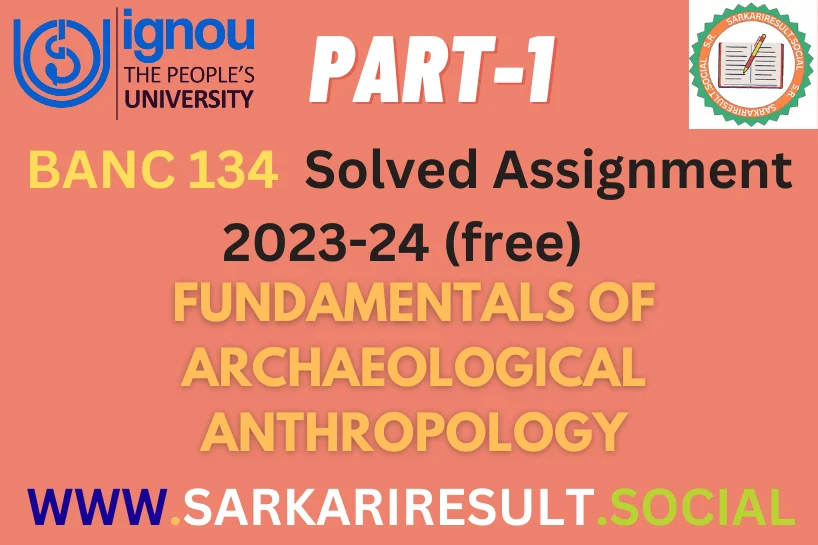BANC-134 IGNOU Solved Assignment 2023-24 (free) Part 1

BANC-134 IGNOU Solved Assignment 2023-24 (free) Part 1
“Embark on an enlightening journey through Archaeological Anthropology with the BANC-134 IGNOU Solved Assignment 2023-24 (free) Part 1. In Assignment I, you’ll find two comprehensive questions, each requiring responses of approximately 500 words. These solved answers will guide you towards success in your IGNOU solved assignments for 2023-24.”

a. Define Archaeological Anthropology. Describe discuss its origin and development in India.
Ans. Archaeological anthropology, also known as archaeological anthropology or anthropological archaeology, is a subfield of anthropology that focuses on the study of human societies and cultures through the examination of material remains and artifacts from the past. This field combines principles of anthropology, archaeology, and various scientific methods to reconstruct and understand the lifestyles, behaviors, and social structures of ancient human populations. Archaeological anthropologists investigate the physical and cultural aspects of human evolution and development over time, shedding light on the diversity of human experiences throughout history.
BANC-133 IGNOU Solved Assignment 2023-24 (free) Part 1
The origin of archaeological anthropology can be traced back to the 19th century when the discipline of anthropology itself was emerging as a distinct field of study. Early anthropologists like Lewis Henry Morgan and Edward Tylor recognized the importance of material culture in understanding human societies. They laid the foundation for the study of cultural evolution and the idea that artifacts and archaeological evidence could reveal insights into the development of human cultures.
In India, the roots of archaeological anthropology are deeply intertwined with the country’s rich archaeological heritage. India has a long history of excavation and exploration, dating back to the 19th century. British colonial administrators and scholars played a significant role in the initial exploration of India’s ancient past. The Archaeological Survey of India (ASI), established in 1861, played a pivotal role in documenting and preserving India’s archaeological sites and artifacts. It laid the groundwork for the systematic study of India’s history and culture.
BANC-133 IGNOU Solved Assignment 2023-24 (free) Part 2
Archaeological anthropology in India developed alongside these early archaeological efforts. Scholars like R. D. Banerji, Daya Ram Sahni, and Mortimer Wheeler made significant contributions to the field through their excavations and research. These pioneers explored ancient Indus Valley Civilization sites like Harappa and Mohenjo-Daro, shedding light on one of the world’s oldest urban civilizations.
Post-independence, India’s archaeological anthropology continued to flourish. Institutions like the Tata Institute of Fundamental Research (TIFR), Deccan College, and the Archaeological Survey of India expanded research and training opportunities for aspiring archaeologists and anthropologists. The discovery of the rock art at Bhimbetka in Madhya Pradesh, dating back to the Paleolithic era, highlighted the antiquity of human habitation in India.
BANC-133 IGNOU Solved Assignment 2023-24 (free) Part 3
Archaeological anthropology in India also embraced interdisciplinary approaches, incorporating insights from fields such as history, geography, geology, and genetics. Scholars began to study ancient texts, inscriptions, and artifacts to reconstruct India’s cultural and social history. Additionally, advancements in scientific dating techniques, such as radiocarbon dating, helped establish more precise chronologies for archaeological sites.
One notable development in Indian archaeological anthropology is the increased focus on the study of tribal and indigenous communities. These studies aim to understand the unique cultural practices, ecological knowledge, and social structures of India’s diverse tribal populations. This approach has helped bridge the gap between academic research and the preservation of indigenous heritage.
In conclusion, archaeological anthropology is a multidisciplinary field that evolved alongside the broader discipline of anthropology. In India, it has a rich history dating back to the colonial period, with significant contributions from scholars and institutions. Today, Indian archaeological anthropologists continue to make valuable contributions to our understanding of the country’s ancient past, cultural diversity, and the interactions between human societies and their environments. This field remains crucial for preserving and interpreting India’s archaeological heritage and contributing to our knowledge of human history on a global scale.
BANC-131 Solved Assignment 2023-24 (free) Part 1
b. Discuss different types of excavation in Archaeological studies.
Ans. Excavation is a fundamental component of archaeological studies, and it involves the systematic uncovering and examination of archaeological sites and remains to reveal insights about past human cultures. There are several different types of excavations in archaeological studies, each with its own objectives, methods, and approaches. Here, we will discuss some of the primary types:
1. Rescue Excavation: Also known as salvage archaeology, this type of excavation is often conducted in response to imminent threats to archaeological sites, such as construction projects, natural disasters, or looting. The goal is to quickly recover as much information as possible before the site is destroyed. Time constraints can make rescue excavations challenging.
2. Systematic Excavation: This is the most common type of excavation in archaeology. It involves the systematic and methodical removal of layers of soil and debris from an archaeological site, often in a grid pattern. The objective is to uncover and document the entire site to understand its stratigraphy and the sequence of human activity over time.
BANC-131 Solved Assignment 2023-24 (free) Part 2
3. Selective Excavation: In selective excavation, archaeologists focus on specific areas or features within a site rather than excavating the entire area. This approach is often used when time, resources, or preservation concerns limit the extent of excavation. It can provide detailed information about specific aspects of a site.
4. Vertical Excavation: In vertical excavation, archaeologists dig deep trenches or pits to expose the layers of a site vertically. This method is useful for understanding the chronological sequence of deposits and can reveal changes in occupation and activity over time.
5. Horizontal Excavation: Unlike vertical excavation, horizontal excavation involves removing layers of soil and debris horizontally across the site. This method is used when the objective is to expose a larger area at a shallower depth. It is particularly useful for uncovering architectural features and settlements.
6. Underwater Excavation: Archaeologists use specialized equipment and techniques to excavate submerged archaeological sites, such as shipwrecks or submerged settlements. Underwater excavation presents unique challenges due to the aquatic environment, but it can yield well-preserved artifacts and structures.
BANC-131 Solved Assignment 2023-24 (free) Part 3
7. Remote Sensing and Non-Invasive Techniques: In some cases, archaeological investigations may rely on remote sensing methods like ground-penetrating radar (GPR), magnetometry, or aerial surveys to map and identify subsurface features without excavation. These non-invasive techniques are valuable for minimizing the disturbance of sensitive sites.
8. Experimental Excavation: This type of excavation involves recreating past conditions or activities to better understand archaeological findings. For example, experimental archaeologists might reconstruct ancient tools, buildings, or agricultural practices to test hypotheses about how they were used.
9. Ethnographic Excavation: Ethnographic excavation combines archaeological methods with ethnographic research, often working with contemporary indigenous communities. It aims to understand the cultural significance and use of archaeological sites and artifacts in the context of living traditions.
10. Forensic Excavation: Forensic archaeology applies archaeological techniques to crime scenes and human remains to aid in criminal investigations. It helps determine the circumstances of death, identify individuals, and provide evidence in legal proceedings.
Each type of excavation serves specific research goals and can provide valuable insights into different aspects of the past. The choice of excavation method depends on factors such as research objectives, site conditions, available resources, and ethical considerations. Regardless of the type, proper documentation, stratigraphy analysis, and artifact preservation are essential aspects of any archaeological excavation to ensure that the information recovered is accurate and can contribute to our understanding of history and culture.







